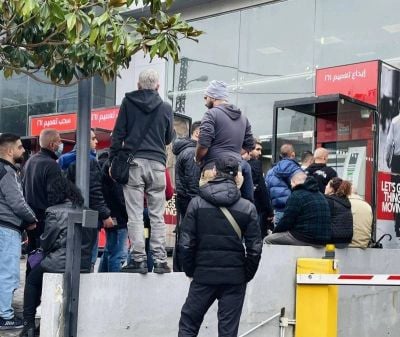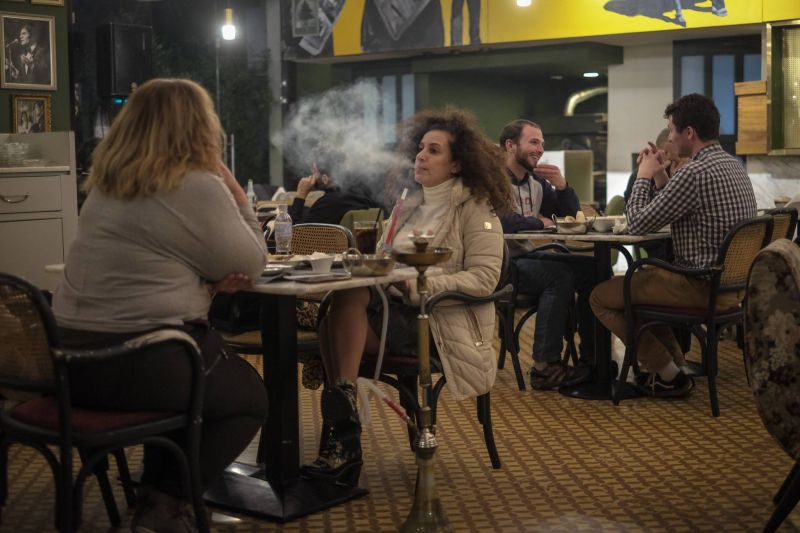
Customers share a meal and argileh at Dar Beirut, in Gemmayze, Jan. 13, 2023 (Credit: João Sousa/L'Orient Today)
BEIRUT — In Beirut’s busy Gemmayzeh neighborhood, restaurant goers flick through their phones. They’re not texting or swiping through dating apps, but choosing what to eat. Paper menus seem to be a thing of the past, phased out by QR codes.
Strangely, prices seem to be in the single and double digits — but that’s because they have a dollar sign next to them.
Restaurants have had to cope with a number of challenges as they recover from the dual fallout from the COVID-19 pandemic and Lebanon’s now three-year-old financial crisis. Two of those biggest challenges are electricity shortages and the volatility of the national currency.
In recent months, many establishments have begun pricing their menus in US dollars instead of Lebanese lira. On the heels of two exceptional decisions made by the Tourism Ministry, the switch has gained steam in the past month and attracted a flurry of online criticism. Many are wondering who the change really benefits.
More restaurants are charging us in USD in Lebanon, but are they paying their staff in USD? pic.twitter.com/LbCR1AVcO6
— محمد/Mo (@monajem) January 9, 2023
Christie, who did not want her real name used in this article, is the co-owner of an up-scale restaurant in Gemmayzeh, says she has had no choice but to price her menus in dollars because most of her expenses are billed in that currency.
“Much of it goes towards the generator [to power the restaurant], which is a problem being faced by everyone,” she says.
Kitchen supplies such as raw meat, chicken, and alcohol are all priced in dollars.
Khoder Issa, who manages Hamra-based restaurant Mezyan and nearby cafe Barzakh explains that, although some of his suppliers accept Lebanese lira payments, their exchange rate is usually LL2,000-LL3,000 above the black market rate. He adds that, before the crisis started, it was common practice to pay for supplies 30 days late.
“Back in the 1500 LL days, suppliers gave us a 30-day line of credit. It was like an offer they used to give you to accept to do business with them,” Issa said. But for both him and Christie, this is no longer the case, driving the urgent need for cash.
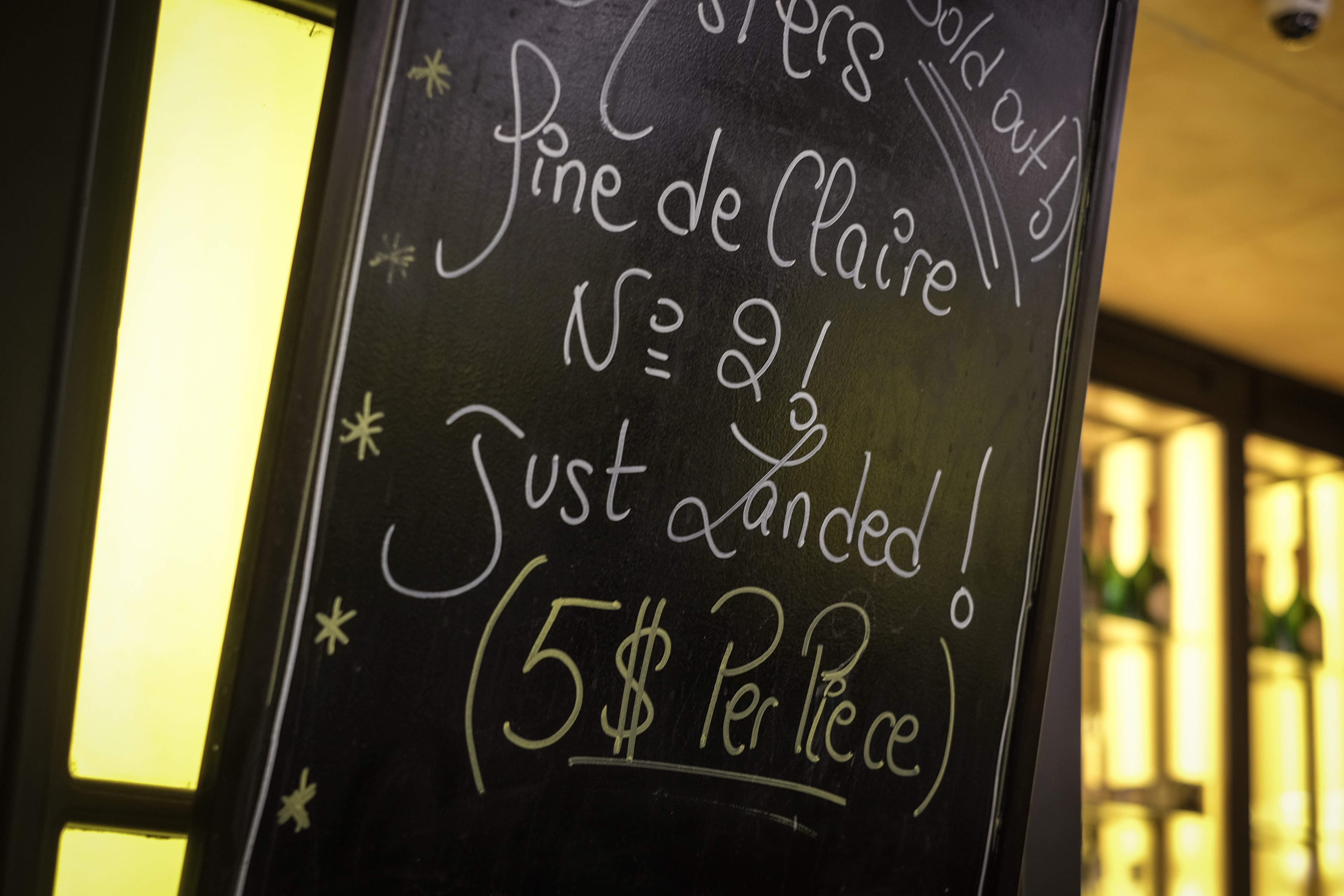 Menu prices in Couqley, Gemmayze, are displayed in dollars, Jan. 13, 2023 (Credit: João Sousa/L'Orient Today)
Menu prices in Couqley, Gemmayze, are displayed in dollars, Jan. 13, 2023 (Credit: João Sousa/L'Orient Today)
Pricing in $ …or in LL, against all odds
Christie says she tried to keep prices in Lebanese lira for as long as possible, but it became unsustainable.
“It takes a lot of time to reprice the menu. You have to send it to the agency and they have to change it on the QR code, and change the prices on the system item by item. By then, the dollar would have risen to LL46,000 and you were already adjusting it to LL44,000.”
Ali Daoud, the owner of Couqley restaurant in Gemmayzeh, says when he reopened his restaurant recently, the menu was automatically priced in dollars: “We kind of waited out until our sector and our target [clientele] started accepting the reality in the market regarding the pricing.”
“We priced as if there was no crisis, and even before we used to revisit our prices every three to six months, depending on the changes in the market or changes we’re introducing in the menu,” said Daoud. “This is the model that we are continuing with.”
Issa continues to keep his menus priced in lira. He says the main goal is “not to make a huge profit at all. We’re just trying to keep the two places running. We are facing a lot of problems, like electricity, consumption costs, and trying to control the prices so we can remain affordable for everyone, not just people who get paid in dollars or who are upper class.”
“Let’s say there’s an individual whose income is in Lebanese lira. Even if he gets paid well, if he sees the menu prices in dollars he’s going to be surprised,” Issa continued. “We will do anything to keep the two places open, even taking long-term loans.”
Khodor Eido, a kitchen manager at a restaurant in Mar Mikhael, explains that, when restaurants price their menus in lira, the prices reflect an exchange higher than the one in the parallel market, “so that restaurants can protect themselves.”
However, Eido admitted that, when the lira’s value increases against the dollar, “the prices on the menu don’t go down.”
Although priced in dollars, customers can pay in lira but at a rate slightly higher than the market rate. Daoud says the difference is LL1,000. Eido explains this is done to protect restaurants from further volatility in rate swings.
At Christie’s restaurant too, customers can pay in either currency according to the parallel market rate. She says a customer is less likely to get sticker shock if they see something priced at two digits instead of six.
“When a customer sees a meal that is over LL200,000, they are shocked. Even though we are all used to it by now,” she adds.
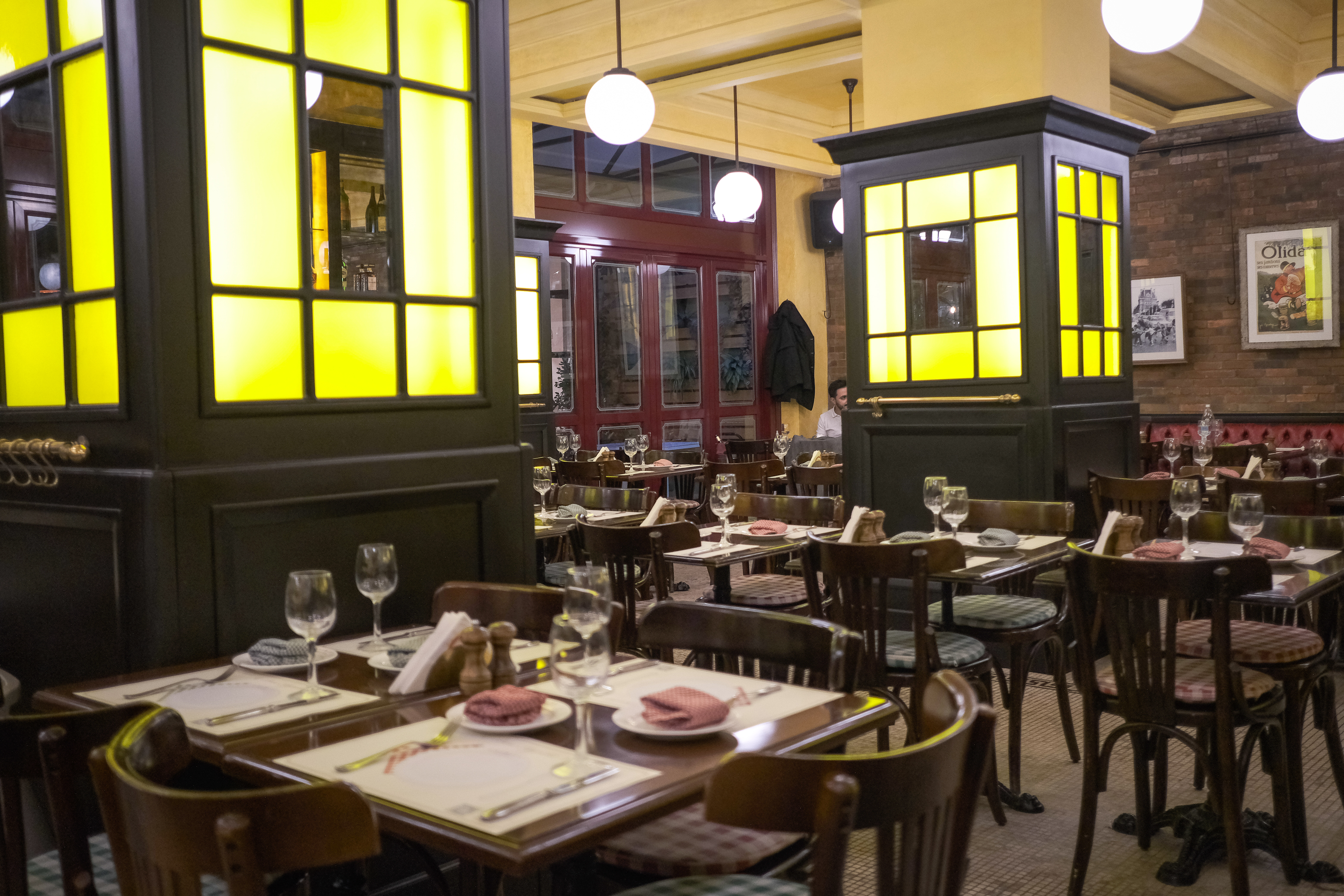 Indoors scene at Couqley, Gemmayze, Beirut, Jan. 13, 2023 (Credit: João Sousa/L'Orient Today)
Indoors scene at Couqley, Gemmayze, Beirut, Jan. 13, 2023 (Credit: João Sousa/L'Orient Today)
Are dollars trickling down to restaurant staff?
Carlos Chehadi, a bartender at a restaurant in Monot, says now, “a huge portion of the bars and restaurants are paying out in dollars.”
“Since July, I've worked in three different places and I've earned dollars. At this point, I won't work in a place unless I'm paid in dollars.''
Christie said her staff has been paid in full dollar salaries for the past three months, and so does Couqley’s Ali Daoud. Both have done so to avoid huge staff turnovers.
“They’re currently getting paid within the market rate or maybe slightly higher,” Daoud tells L’Orient Today. “The salaries also get revisited every couple of months even if they’re in dollars because the cost of living is increasing even in dollars.”
But dollarized salaries are not the case everywhere.
Eido explains that many restaurants have different methods of paying their staff: full lira salaries, half dollar/half lira, or small but fully dollarized salaries.
“I am earning LL10 million [per month], which is about $200. A kitchen staff boy makes LL6 million, which is nearly $100, ” Eido added. “In reality, they charge you, as a customer, dollars to cover expenses, but they do not give the workers their rights.”
He also noted that the increase in restaurant prices usually covers the rising cost of supplies and electricity, gas, and rent, all priced in dollars.
Eido added that the prices on the menu are affected by the rise in commodity prices, with the most recent shock arising after the Russian Invasion of Ukraine, which sent the price of gas, wheat and cooking oil through the roof.
Issa pays his employees at Mezyan and Barzakh in lira. He says there is little difference when it comes to the final amount.
“Let’s say you’re paying someone LL10 million, he says he wants to leave and work someplace else where he can get paid in dollars. But the other place will pay him five million and $100. So it’s the same thing. It’s like they’re giving him LL10 million, but it’s just the idea of getting paid in dollars.”
 Customers socialize outside a coffee shop in Zgharta, April 28, 2022(Credit: João Sousa/L'Orient Today)
Customers socialize outside a coffee shop in Zgharta, April 28, 2022(Credit: João Sousa/L'Orient Today)
Tips, the backbone of the industry
Tipping — which many have called the backbone of the service industry — has also been impacted by the crisis.
When he worked as a waiter in 2018, Eido says, at most, he used to make $900 in tips on a good week during the high tourist season.
“Now because of the crisis, the customer thinks twice before tipping.”
Daoud says that the average tipping rate is slightly less compared to 2019, in terms of percentage. But this depends on the day.
“Some clients are still paying on average 10 percent and some dropped it to 5 percent. Others tip 10 percent but on average, slightly lower. But not by a big gap.”
As a longtime bartender, Chehade distinguishes between high-end places and others.
“The tips depend on the restaurant or bar, the area or the clients themselves,” he says. “For example, in Mar Mikhael, Gemmayzeh or Debayeh, the tips are in Lebanese lira and depend on the season and the holidays. But in places like Monot, which is a very high-class area, 75 percent of people tip in dollars.”
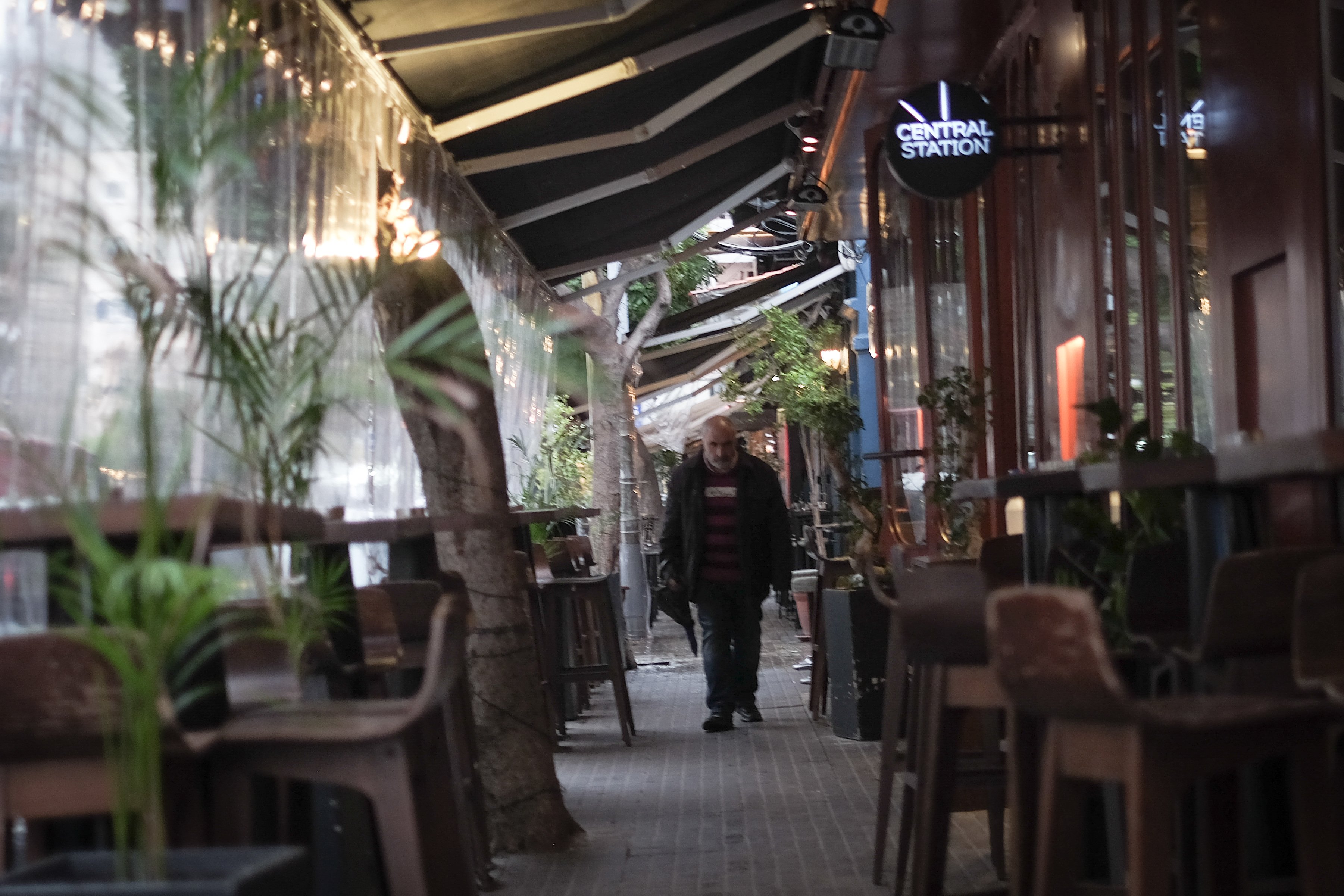 An empty street scene in Mar Mikhail during the daytime, Beirut, Jan. 13, 2023 (Credit: João Sousa/L'Orient Today)
An empty street scene in Mar Mikhail during the daytime, Beirut, Jan. 13, 2023 (Credit: João Sousa/L'Orient Today)
But not all tips go to the waiters.
“In Lebanon, there are two tipping systems that work,” Eido explains. There are restaurants that have tip boxes, where all tips collected from customers are put in the box and, at the end of the month, they are divided up equally between all employees— kitchen staff, waiters, runners, stewards, or bartenders.
In other models, waiters have their own sections with allocated tables, and the tipping system follows a percentage where the waiter needs to pay 3 percent of the sales to the management, who distributes them to the kitchen staff as tips.
If there’s not enough or no tip at all, “I have to pay out of pocket,” explains Eido. “If the table doesn't leave a tip between 5-10 percent, I have to pay it and it can hurt [me], so it's better if people pay 5-10 percent, 3 percent is paid and I’m allowed to keep the rest.”
“Anyone working in this field depends on a lot of tips” to avoid spending all their salaries on basic stuff like transport, Chehade concludes. He estimates that “a good amount [of tips] is between LL3-4 million every week.”
